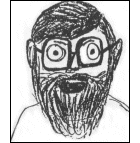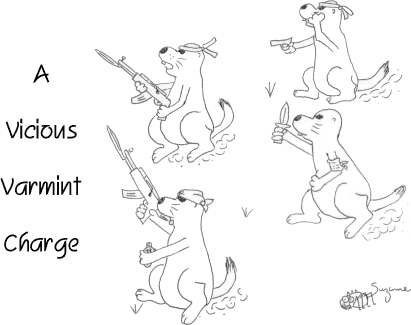
(first printed in Varmint Hunter Magazine October 1995)
By James Calhoon
Or is it nobler to shoot the 223 as a Bee, could THAT be the answer?

Hunting coyotes, rock chucks and prairie dogs usually means a
good stiff load when you're shooting the popular 223. When hunting
these varmints, you are usually well away from areas where noise
is of much concern, other than maybe to the ears of your hunting
partner. As we 223 shooters are aware, the 223 performs admirably
out to approximately 300 yards with a whack of good stopping power.
| However, every now and then it would be nice to have a .218 Bee or a Hornet. I've shot fox with the 223 loaded with 50 or 52gr. bullets and it's usually the same old story; the hide gets blasted. Quite often, while hunting gophers (ground squirrels), I'm shooting amongst cattle and sometimes right into farmers' yards. Unless your landowner/host is an accomplished varminter himself, the blasting of a 223 in the yard can be unnerving, especially if they are expecting only a rimfire. Besides, pursuing gophers with a fully-loaded 223 at ten feet has always seemed over-kill to me, although my shooting partner, Barry, would disagree. |

|
| The Author's rendition of Barry |

I chose to use the James Calhoon 37gr. Dbl
HP bullet (designed for the fancy .22 Cooper rifles) which work
around 2300 fps (the James Calhoon 37gr. Dbl HP bullet will actually
stay together up to around 4000 fps). If I want more weight in
windy conditions, I use a James Calhoon 42gr. Dbl HP bullet. I
started out using 296 Ball powder, but I was not impressed with
the grouping and noted the odd hangfire at reduced loads. I came
to the conclusion that the preferred type of powder for a reduced
load in a 223 would have to be a flake powder. Ball and even stick
powders are much too dense to be considered for reduced loads
in the 223. With the case only half charged or so, a bulky fluffy
powder guarantees ignition to be consistent.
Further tests did prove IMR 800X to be the best reduced-charge
powder for the 223/37gr. Dbl HP combination. The 800X works well
right down to three grains of powder and does not require a wad
to maintain good ignition. Two grains of powder will cause the
bullet to stick to the barrel. The three to four grain load also
makes a good "basement" load for a contender, basically
duplicating a .22 rimfire load. No wadding is required. Other
pistol/shotgun powders can be used as long as it is a flake powder,
but 800X works well, right from a minimum of three grains up to
a twelve grain maximum.
To us rifle shooters, 800X is peculiar-looking stuff. It has to
be the largest-looking flake (around 3/32" in diameter) powder
I've seen. I can't say it meters real well, well enough though,
but it sure bulks up. For example, with my measure set of eleven
grains of 800X, the measure threw fifteen and a half grains of
2015BR (short stick rifle powder). That comes out to 41% more
bulk.
When using 800X, I've found the powder to leave quite a bit of
"Muzzle Mud." That's the black cake stuff you get on
the crown after fifty or sixty shots. I'm presuming that's a graphite
or carbon buildup from the powder. I've used Unique and have had
virtually no "Muzzle Mud," but the barrel fouls twice
as fast as with the "dirtier" 800X. Maybe overly clean
burning powder is not necessary, or even desirable. Powders that
leave a good deposit of graphite should, and appear to, dry lube
the barrel and reduce fouling. I'd like to hear from powder makers
out there on this theory.
|
Reduced Charge Loads for the .223 Using a 37-Grain Calhoon Double HP Bullet |
||||
| 800X | Blue Dot | |||
| Powder Charge | Velocity | Powder Charge | Velocity | |
|
3.0 gr 4.0 gr 10.0 gr 11.5 gr |
1,250 1,350 2,900 *3,125 |
4.0 gr 14.0 gr |
1,275 *3,240 |
|
|
|
||||
| 800X | Blue Dot | |||
| Powder Charge | Velocity | Powder Charge | Velocity | |
|
3.0 gr 4.0 gr 10.5 gr |
1,170 1,270 *2,850 |
4.0 gr 13.0 gr |
1,165 *3,000 |
|
|
*MAX LOADS |
||||
As most of you know, graphite is a super
slippery black powder which is added to grease to improve performance
under extreme pressure. Isn't that what we're after; improving
performance under extreme pressure? How about that fella from
Silver Eagle Machine in Glendale, Arizona, who makes the graphite
wax wads? I'd like to see some test results. Groups before and
after the wads; how many shots before the groups go. The graphite
to use for bullet application should be "colloidal graphite"
which is made electrically and is the purist form of graphite.
It looks like tiny ball bearings (under a microscope) and does
not break down into carbon as does regular graphite under high
heat and pressure.
Anyway, good accuracy is achieved across the loading range using
800X, with exceptional groups as loads reach maximum (under 1/2")
- groups as good as your regular 50/52gr. loads can be expected.
With eleven grains or more of 800X and the 37gr. Dbl HP, elevation
at 100 yards is roughly 1/2" low from your normal 223 load.
Windage should hold. As expected, this light load will be pushed
around by the wind, about twice as much as the 50gr. standard
load. I usually limit my shots to 100 yards in strong winds. On
a calm day, 150 yards is not difficult.
For distinguishing, your reduced loads, a dab with a blue marker
(blue for cool) on the primer makes them easy to pick out from
your regular 223 loads. Barry uses his crayon.
If you load your cases one at a time into the chamber, all you
have to do is make a choice. For a magazine gun, I keep the mag
loaded with regular loads, minus one or two. This gives me the
option of feeding a regular round from the mag or inserting a
reduced load into the mag.
My favorite reduced load for my 223's is eleven and a half grains
of 800X behind a 37gr. Dbl HP. This load  produces
recoil similar to the .17 Reminegton, has a report like a Hornet,
and hitting power that surprised even Barry. Barry says "I
DO like that load!"
produces
recoil similar to the .17 Reminegton, has a report like a Hornet,
and hitting power that surprised even Barry. Barry says "I
DO like that load!"
I prefer a NECK sizer only. The Forester/Bonanza seater is very
good.
The 221 Fireball and 222 Remington also work well using reduced-charged
loads. For reduced loads in the 222 Remington, reduce maximum
load by one grain of powder from the 223. For reduced loads in
the 221 Fireball, reduce maximum load by two grains of powder
from the 223.
Shooting reduced load 223's makes two rifles out of one. Instead
of bringing along two rifles, I now just bring another bucket
of ammo. I certainly have no need for a rimfire anymore, especially
considering the accuracy, versatility, cooler shooting, and convenience
of a reduced load 223.
For further discussion, call James (406)395-4079 (Mon. through
Fri., 8-2 MST). If you call, you won't be talking to Barry. He's
too shy.